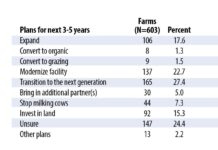UNIVERSITY PARK, Pa. — Recent news reports about the novel H1N1 virus being discovered in Minnesota and Indiana pigs left a lot of people scratching their heads, wondering why — with a frightening flu pandemic spreading in humans around the world — it is important that the virus that causes it has been found in Land of Lakes swine.
The answer is, according to an expert in Penn State’s College of Agricultural Sciences, “it really depends.”
Complicated
It’s a complicated question, explained extension veterinarian David Wolfgang, who said the novel H1N1 virus already has been found in pigs in Mexico, Norway, and Alberta, Canada.
“The Minnesota situation is the first time the particular H1N1 virus that is causing the flu pandemic has been found in pigs in (the United States),” he said. “That’s why it made headlines and received so much attention.”
Often referred to as the swine flu, the H1N1 virus causing the flu pandemic is mostly a swine virus, Wolfgang said, “with a smidgen of bird flu material and a smidgen of human flu virus material.”
It doesn’t make pigs very sick, and people can’t contract it by eating pork products.
Potential threat
“H1N1-type viruses have been in pig populations for a long time, and this one seems to make pigs sniffly for a few days and then they get over it,” he said, “but the fear is that if this particular virus gets into commercial pig herds of many thousands of animals, and it recombines with more swine or avian genetic material, it might come out as a new virus that could prove deadly to humans because we would have no immunity to it.”
It is that threat of recombination of the virus that concerns scientists, Wolfgang said.
“Pigs can get the virus from birds and from people, and the infections go both ways. We share some influenza viruses with pigs. Plus pigs can share some influenza viruses with birds, especially waterfowl.
“As the virus goes back and forth and spreads around, a resorted virus has the potential to make more animals or people ill.”
So the USDA and other government and private entities are trying to prevent the novel H1N1 virus from entering and spreading in animal populations.
From humans to pigs
Fortunately, the pigs in the Minnesota case were not part of a commercial herd. (The samples in Indiana, confirmed Nov. 2, were from a commercial herd.)
“What happened in the Minnesota case was interesting because the three pigs in question were being shown at the state fair and were exposed to a group of 4-H youth,” Wolfgang explained. “Many youth in this group were sent home sick with what was diagnosed as the H1N1 flu. Officials believe that’s how the pigs got it, and after they were infected, the animals were never in contact with other pigs.”
The “take-away message” from the Minnesota case, Wolfgang said, is that the close surveillance of swine herds and poultry flocks by agricultural officials and veterinarians is vital for protecting human health.
On top of it
Scientists are not watching just for influenza, but also for other zoonotic diseases — illnesses that can infect both humans and animals.
Wolfgang pointed out that such surveillance is one of the primary functions of Penn State’s Animal Diagnostic Laboratory, which is one of three labs in the Pennsylvania Animal Diagnostic Laboratory System.
Penn State’s lab tests thousands of samples for avian influenza annually and is certified to test for H1N1 in swine.
“It is important that we continue to monitor influenza viruses and other diseases in animal populations to be sure they are not changing and making animals sicker or becoming more dangerous to humans,” he said. “That way we are warned about impending crises and have time to react.”









